Everyone loves chicken Alfredo, but it’s surprising just how expensive it can be when ordering out, considering the simple ingredients. This recipe not only saves you money, but you’ll fall in love with just how easy (and delicious) it is. Once you go homemade, you’ll never go back!
For more delicious Alfredo sauce, try our Creamy Alfredo Pizza or Chicken Alfredo Pizza.

Why My Recipe
- 35 minutes to make, yet still produces a restaurant-quality result.
- Thickened with an easy roux for a smooth, velvety sauce.
- Simple ingredients and easy-to-follow steps for pasta night.
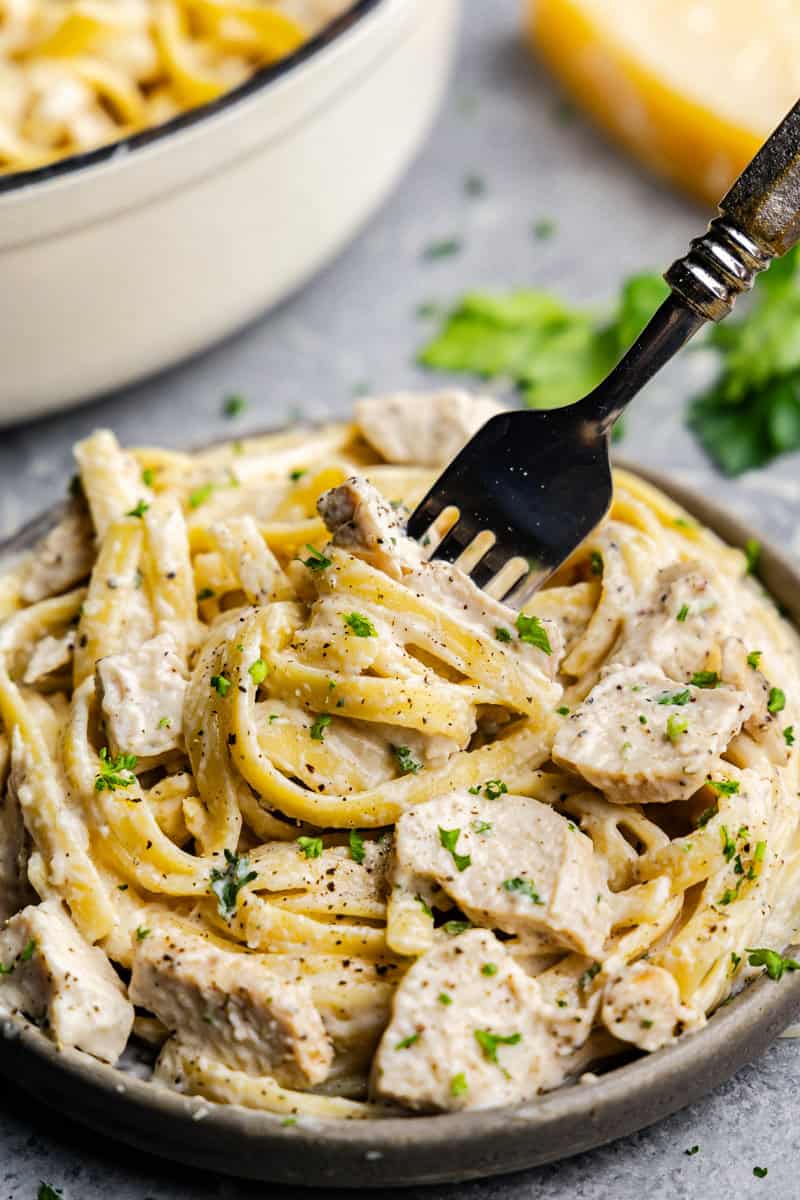
Originally, Alfredo was made with just pasta, butter, and parmesan. It’s evolved over the years, and the Alfredo sauces that you find at the grocery store, as well as at many restaurants are more of a bechamel-based sauce. This recipe is not the original Alfredo, but rather part of the evolution of Alfredo sauces. It’s meant to be creamy, comforting, a little indulgent, and super easy to make.
Ingredient Notes
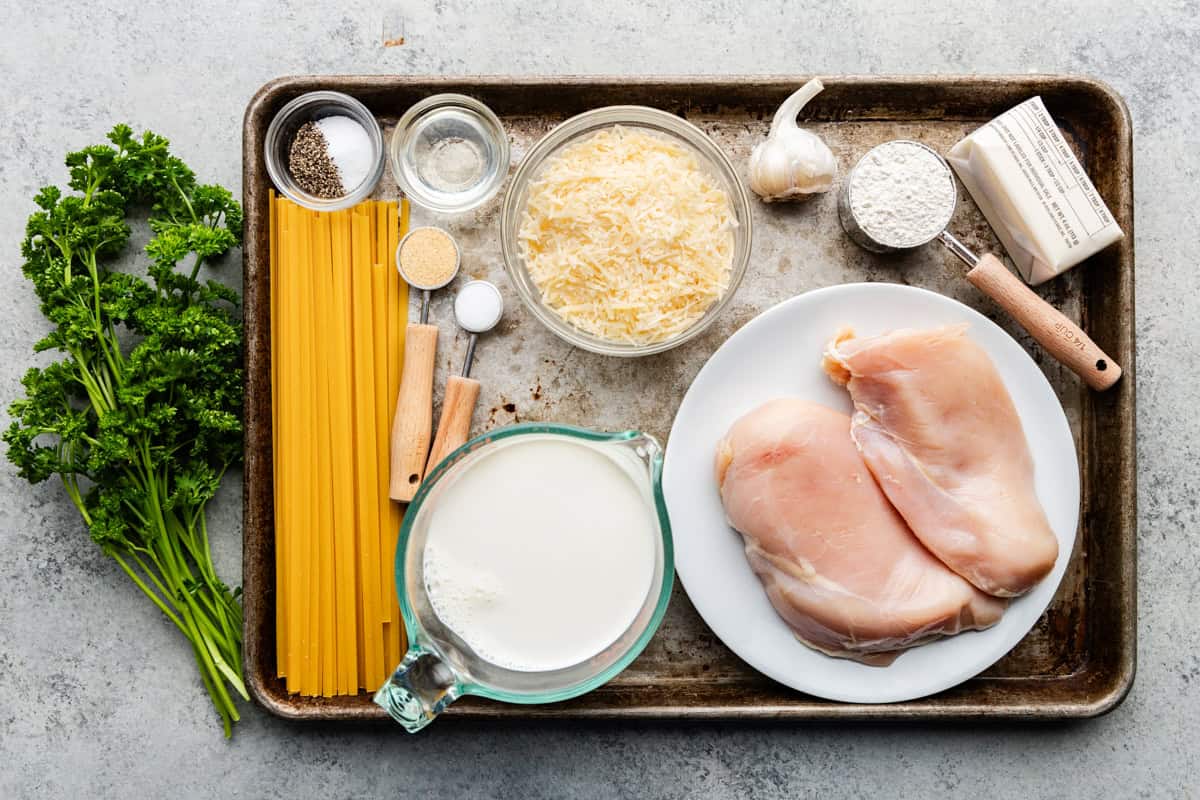
- Fettuccine: Long noodles like Fettuccini or Linguine are traditional but Penne is also a popular noodle for this dish.
- Chicken Breasts: Boneless, skinless chicken breasts are ideal for this recipe. Dice into bite-sized pieces.
- Cooking Oil: You can use any neutral cooking oil like canola, avocado, or vegetable oil.
- Garlic: Freshly minced garlic provides the best flavor, but jarred minced garlic works in a pinch.
- Granulated Garlic: Used in the sauce, providing a subtle background flavor without overpowering the dish.
- Butter: Mixed with flour for the roux (sauce base). We use salted butter but you can use unsalted to control the sodium content.
- All-Purpose Flour: Stick with all-purpose for best results. Bread flour also works.
- Half and Half: Makes the sauce extra creamy without being too heavy. You could also go all out and use heavy cream.
- Parmesan Cheese: As with any Alfredo recipe, you’ll get better results if you use freshly grated. Pre-grated varieties don’t melt as smoothly and can make the sauce gritty.
- Chicken Broth: Optional, for thinning the sauce if needed.
- Parsley: A fresh garnish that adds a pop of color. It’s optional, but makes you look like a pro!
Using Rotisserie Chicken
If you’re short on time or want to save money, shredded rotisserie chicken is a great shortcut for chicken alfredo. Simply remove the skin, shred the meat, and stir it into the sauce once it’s finished.
Since the chicken is already cooked, you’ll only need a couple of minutes on low heat to warm it through. This method saves cooking time and adds extra flavor from the seasoning on the rotisserie.
Sneak in a Veggie
This recipe is delicious on its own, but you could easily add in some steamed broccoli, asparagus, or sautéed spinach to add some green. Just toss them in with the pasta. This is a great use of leftover or microwaved veggies!
Substitutions and Variations
Cheese: Swap some parmesan for pecorino romano or asiago for a sharper flavor.
Dairy-Free: Use plant-based butter and unsweetened oat or almond milk thickened with a little extra roux. Add nutritional yeast for cheesy flavor.
Gluten-Free: Use gluten-free pasta and a 1:1 gluten-free flour blend for the roux.
Lighter Option: Use milk instead of half and half, though the sauce will be thinner.
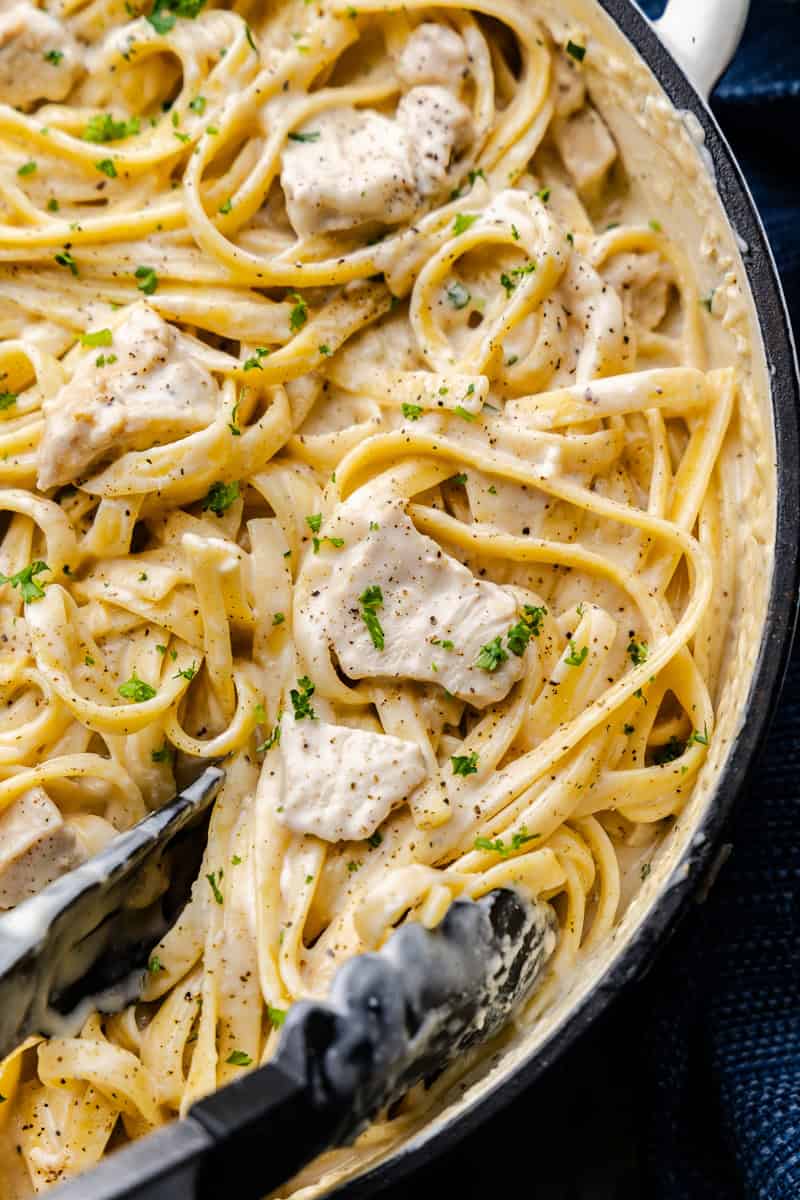
Making a Roux
If you’ve never made sauce from scratch before, you’ll be surprised at how easy it is. A roux is just equal parts butter and flour cooked together before adding liquid — the secret to a smooth sauce.
Pro tip: make sure you let the butter and flour mixture cook for a full 1-2 minutes before adding the milk or broth. Raw flour really needs that time to cook for the best flavor. You want this mixture to have a golden color before adding the liquid.
Common Mistakes to Avoid
Even simple recipes have a few pitfalls. Here’s how to make sure your chicken alfredo turns out smooth and flavorful every time:
Overcooking the Chicken: Pull it from the pan as soon as it reaches 165°F to keep it juicy.
Rushing the Roux: Give the butter and flour time to cook for 1–2 minutes before adding liquid or the sauce will taste floury.
Adding Cheese Too Quickly: Stir in parmesan off the heat or on very low so it melts smoothly without clumping.
Skipping Pasta Water: A splash of starchy water helps thin the sauce and bind it to the pasta.
Cooking Pasta Too Early: Time the pasta so it’s ready just as the sauce finishes — that way it doesn’t stick or dry out while waiting.
Frequently Asked Questions
This usually happens if cheese is added too quickly or over too high a heat. Lower the heat and add cheese gradually, stirring until melted.
For thinner sauce, add a splash of chicken broth or half and half. For thicker, simmer longer or add more parmesan.
Yes. Cook the sauce and chicken separately, store in the fridge, and combine with fresh pasta when ready to serve.
Linguine, tagliatelle, or even penne all hold the sauce well.
It’s not recommended — creamy sauces can separate after thawing.
Serving Suggestions
Chicken alfredo is rich and creamy, so it’s nice to balance it with lighter, fresher sides. Here are some easy options to round out the meal:
Garlic Bread: Perfect for soaking up every last bit of sauce.
Caesar Salad: Crisp romaine and tangy dressing cut through the richness.
Roasted Vegetables: Asparagus, zucchini, or broccoli add color and freshness.
Caprese Salad: Juicy tomatoes, fresh mozzarella, and basil keep things light.
Simple Green Beans: Steamed or sautéed with a squeeze of lemon.
Storage & Reheating
Refrigerate leftovers in an airtight container for up to 3 days.
Reheat on the Stove: Heat 2 tablespoons of water in a skillet over medium-low heat. Add the pasta and stir constantly until warmed through and the sauce becomes creamy again. Adding water helps revive the sauce without separating it.
Reheat in the Microwave: Place portions in a microwave-safe dish and sprinkle 1 tablespoon of water over the top. Cover with plastic wrap and microwave on medium heat in 30-second intervals, stirring in between to ensure the sauce stays smooth.
More delicious pasta recipes…
This is the easiest alfredo recipe and so delicious! It always comes together so perfectly and it’s fast! My family loves it!
– Steph
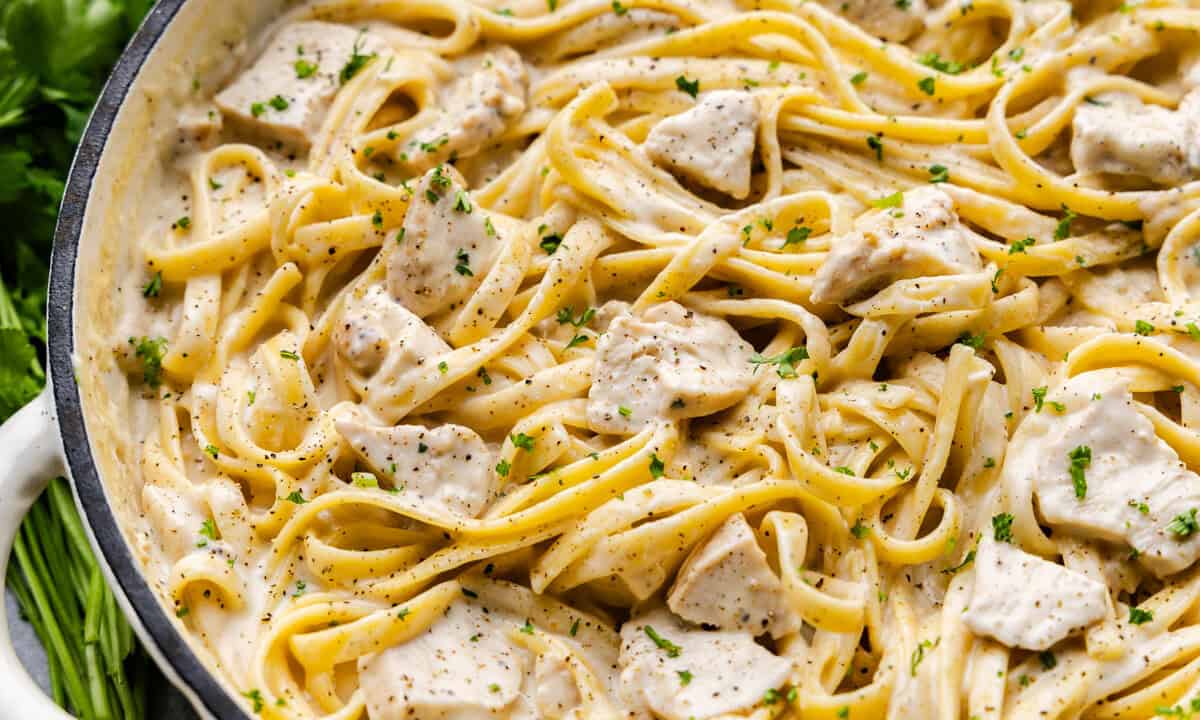
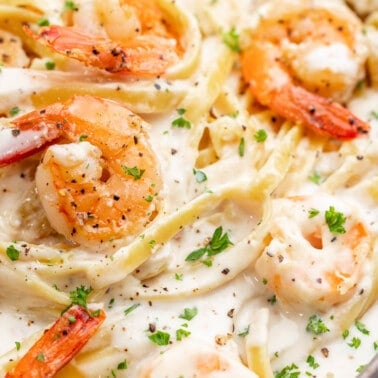
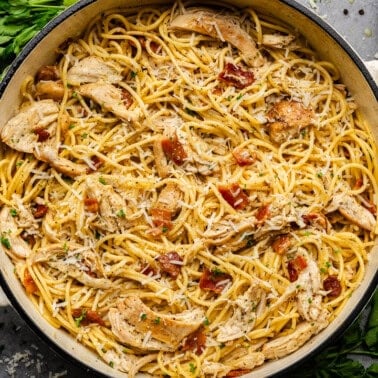
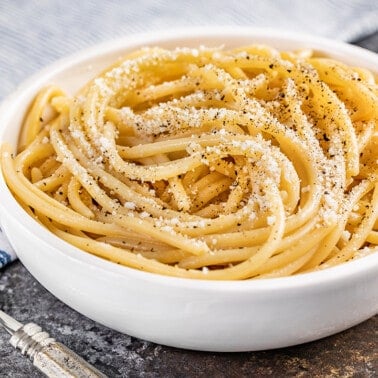
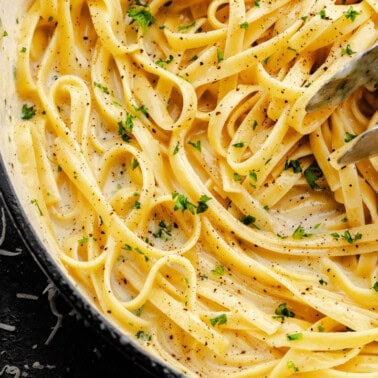
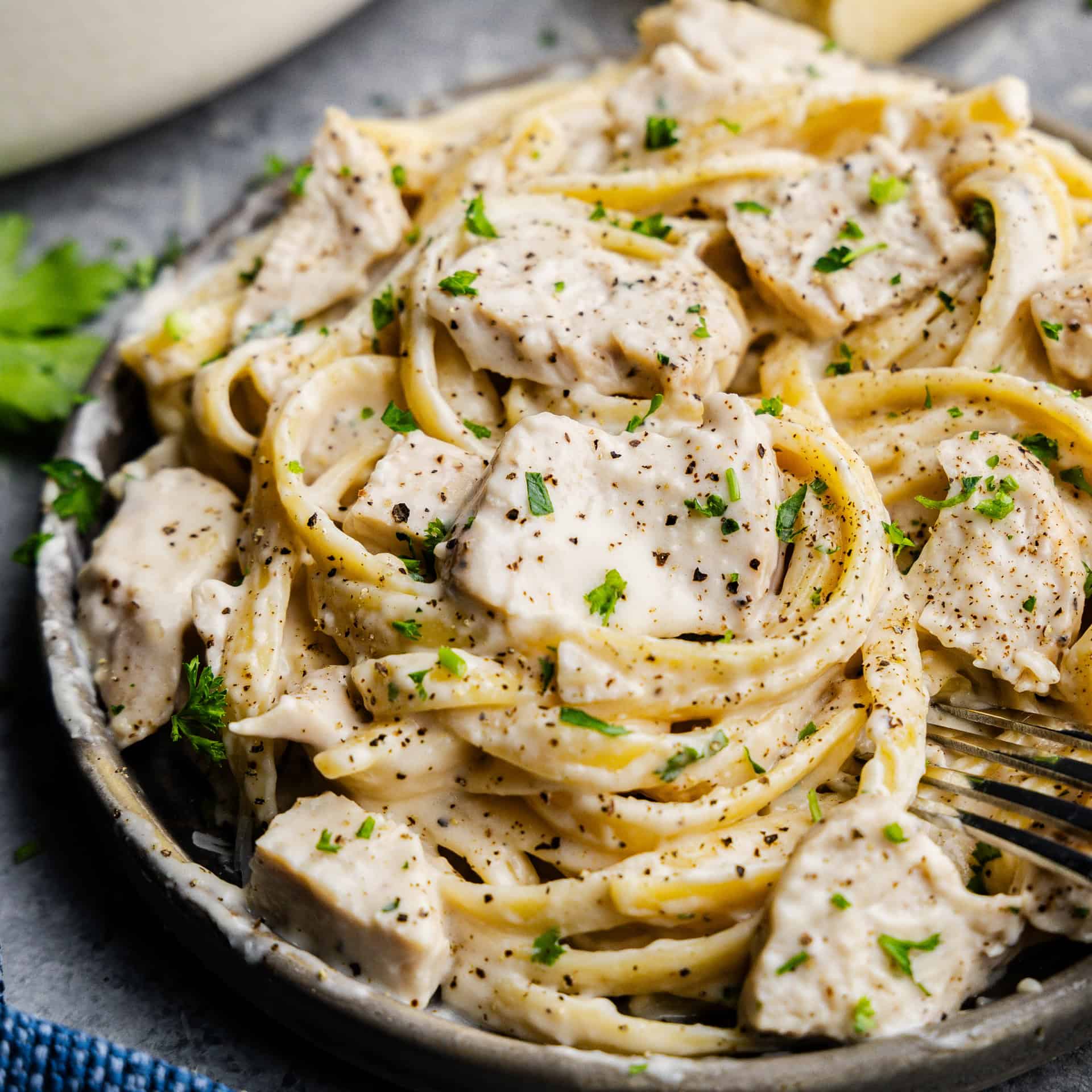
I make this using the whole breast method; generously peppering and lightly salting them before cooking. I’ve also learned to pound them out at the thicker parts so they cook more evenly. For the sauce I use about a 1/2 cup less cheese than what’s called for because it gets almost too thick. But this is easy, and a go to for us! Thank you!
Tried this for the first time – flavors spot on. it made a large amount of sauce – I cooked 3/4 lb of fettuccini instead of 1/2 pound and next time will use the full pound package. Sauce was a little thick and had I read more comments I would have probably thinned down with some pasta water but I was afraid of making it grainy or too runny. Once I added the cheese it became so cheesy I was afraid to add anything to make it thinner – I’m notorious for a last minute of ruin of creamy sauces. Thank you for this easy recipe – can’t wait to make this for my friends!
When using broccoli is it better to use fresh broccoli or frozen broccoli ?
It is definitely a preference of what is best for you!
Delicious. Used heavy cream thinned down with whole milk. Could have used 1/2n1/2 but delicious
Loved this sauce recipe- thank you for sharing. Because I enjoy reading comments about what other cooks might do for change ups I’ll share mine. I sauteed chopped garlic in the butter before adding the flour for my roux (we enjoy the fresh garlic in our fettuccine) and I added dried basil and oregano leaves for an Italian flair. I also found that thinning out the sauce with some reserved pasta water worked better for me than adding extra milk. Sundried tomatoes are a nice addition as well which I did one time. My family really enjoys this recipe. Two thumbs up!
My guests enjoyed this meal, and it was so easy to prepare. I used sliced, grilled chicken breasts. Your recipes are perfect for my husband and me, and guests.
This is the easiest alfredo recipe and so delicious! It always comes together so perfectly and its fast! My family loves it!
Tried this today…excellent!! Very rich and a little thick, so added some chicken broth. Flavor was on point. Will definitely go in my dinner rotation.
Absolutly wonderful, delicious, full of flavor & simple to make, Alfredo is one of my favorites.i also dip it with french bread.
Recipe made a lot of sauce- next time I will make a pound of fettuccine instead of 1/2 pound